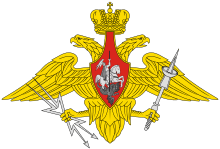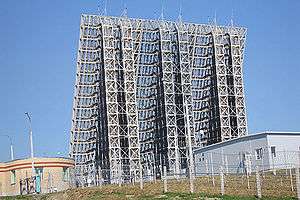Russian Aerospace Defence Forces
The Aerospace Defence Forces Branch (ASDFB)[1] (Russian: Войска воздушно-космической обороны (ВВКО), tr. Voyska vozdushno-kosmicheskoy oborony (VVKO))[2] was a branch of the Armed Forces of the Russian Federation responsible for aerospace defence, and the operation of Russian military satellites and the Plesetsk Cosmodrome. It was established on 1 December 2011 and replaced the Russian Space Forces.[3] The ASDFB was first commanded by former Space Forces commander Colonel General Oleg Ostapenko, who was promoted to Deputy Minister of Defence in November 2012.[4][5] On 24 December 2012, Aleksandr Golovko was appointed the new commander.[6] Although it is officially translated as aerospace in English,[7] it covers both attacks from the air and from (outer) space, and some Russian writers translate it as "air and space" instead.[4][8]
| Aerospace Defence Forces Branch (ASDFB) | |
|---|---|
 Emblem (medium) Aerospace Defense Forces | |
| Active | 1 December 2011–1 August 2015 |
| Country | Russia |
| Type | Aerospace Defence |
| Anniversaries | 4 October (Space Forces Day) 12 August (Air Force Day) |
On 1 August 2015, the Russian Air Force and the Russian Aerospace Defence Forces were merged to form the Russian Aerospace Forces.[9][10]
The Russian Aerospace Defence Forces duties for space defense are now with the Russian Space Forces under the umbrella of the new Russian Aerospace Forces. The RADF today only provides air defense responsibilities.
History
| Armed Forces of the Russian Federation |
|---|
.svg.png) |
| Staff |
| Services (vid) |
| Independent troops (rod) |
| Special operations force (sof) |
| Other troops |
|
| Ranks of the Russian Military |
| Uniforms of the Russian Military |
| History of the Russian military |
The Aerospace Defence Forces trace their heritage to the Space Operations Section, Strategic Operations Branch of the Supreme High Command Reserve Artillery, formed in 1955, and transformed into the Space Services Central Administration of the Strategic Missile Forces in 1964 (and later the Chief Space Operations Directoriate in 1972).
In 1967 the Anti-Missile and Space Defence Forces were formed (Russian: войска противоракетной и противокосмической обороны [ПРО и ПКО], tr. Voyska Protivoraketnoy i Protivokosmicheskoy Oborony [PRO i PKO]) under Artillery Lieutenant General Yu. Votintsev.[11] They were reorganised as the Ministry of Defence Space Service Units in 1982, and were expanded to include the Chief Space Operations Directorate in 1986. In 1991 the Soviet Union was broken up. The Russian Armed Forces were established on 7 May 1992, enabling the creation of Russian Space Forces later that year on 10 August. They were merged with the Strategic Missile Troops in 1996, but were reformed in 2001.
In 2006 President Vladimir Putin agreed with the idea of a new "Air and Space Defence Concept" from 2016, but without the implication that it would be a separate service. In 2008 Aleksandr Zelin argued that the missile defence and space defence forces should be merged into the Air Force.[8]
On 30 November 2010 President Dmitry Medvedev said that air and space defence services would be under a single strategic command and the General Staff and Ministry of Defence had decided it would be on the basis of the Space Forces. In April 2011 the then Space Forces commander Oleg Ostapenko said that concept for the future system had been approved. The service was created by the presidential decree "On changes to the composition of the Russian Armed Forces until January 1, 2016" which has not been published.[8]
Thus, on 1 December 2011, the Space Forces became the Aerospace Defence Forces, fusing all space and some air defence components into one joint service. On 1 August 2015, the ADF was merged with the Russian Air Force to form the Russian Aerospace Forces, by orders of the President of Russia Vladimir Putin, and upon the recommendation of the Minister of Defense Sergei Shoigu. It is today a service speciality corps within the Aerospace Forces with responsibility for the aerospace defense of Russian territory.
Organisation
Until 12 August 2015 the Aerospace Defence Forces was organized into 2 commands: the Air and Space Defence Command; and the Space Command. The structure was as follows:[4][7][8]
- Space Command (Russian: Космическое командование (KK)):
- 153rd Main Trial Centre for Testing and Control of Space Means named after G.S. Titov at Krasnoznamensk (Russian: Главный испытательный центр испытаний и управления космическими средствами имени Германа Титова)
- 820th Main Centre for Missile Attack Warning (SPRN) (Russian: центр предупреждения о ракетном нападении (цпрн)) in Solnechnogorsk
- 821st Main Space Surveillance Centre (SKKP) (Russian: центр контроля космического пространства (цккп)) in Noginsk-9, Moscow Oblast.
- Dunay-3U radar
- Krona space object recognition station, Zelenchukskaya, Karachay-Cherkessia
- Krona-N, Nakhodka, Primorsky Krai
- Moment space surveillance complex, movable
- Okno, Tajikistan
- Okno-S, Primorsky Krai
- Air and Space Defence Command (Russian: Командование противовоздушной и противоракетной обороны (К ПВО И ПРО)):
- 9th Missile Defence Division (A-135 anti-ballistic missile system) in Pushkino[12]
- 4th Missile Defence Brigade in Dolgoprudny
- 5th Missile Defence Brigade in Vidnoye
- 6th Missile Defence Brigade in Rzhev
- State Testing Plesetsk Cosmodrome (Russian: Государственный испытательный космодром «Плесецк» (ГИК «Плесецк»))
- Kura Test Range
In early March 2014, spokesman of the forces said the aerospace defences would include a space -and ground-based intelligence- gathering and missile early warning network, an air and space defence command, a VKO command-and-control structure, and a logistics support branch. Deputy Defence Minister Yury Borisov said on that month that the military would invest 2 trillion rubles ($55.3 billion) in building up its aerospace defence weapons over the next six years to ensure they are capable of thwarting existing and future types of air and space attacks.
The Aerospace Defence Forces had locations across Russia and bases in some Commonwealth of Independent States countries such as early warning radars in Azerbaijan (until December 2012), Kazakhstan and Belarus, and the Okno facility in Tajikistan. For a more detailed list of air bases now used by the Russian Aerospace Forces, see List of Soviet Air Force bases
Facilities
Until 2015 the VKO operated the following facilities for aerospace defence operations, with the merger of the Air Force it also now handles the operations of Russia's hundreds of air defense bases and air defense units as well.
Early warning of missile attack:
- Voronezh radar at Lekhtusi, Armavir, Kaliningrad, Mileshevka, Yeniseysk, Barnaul[13]
- Daryal radar at Pechora
- Volga radar at Hantsavichy
- Dnepr radar at Balkhash, Irkutsk and Olenegorsk
- Oko early warning satellites
Space surveillance:
- Okno in Tajikistan
- Krona in Zelenchukskaya and Nakhodka
- RT-70 in Yevpatoria (since the 2014 Crimean crisis, the status of Crimea, and thus of the city of Yevpatoria which is located on Crimea, is under dispute between Russia and Ukraine; Ukraine and the majority of the international community considers Crimea and Yevpatoria an integral part of Ukraine, while Russia, on the other hand, considers Crimea and Yevpatoria an integral part of Russia[14]) and Galenki (together with Roscosmos)
Missile defence:
Satellite Systems:
- Liana space reconnaissance and target designation system (2 satellites of electronic reconnaissance 14F145 "Lotus-C1")
See also
- Air Force Space Command
- Zhukov Air and Space Defense Academy
- Main Centre for Missile Attack Warning
References
- Войска воздушно-космической обороны (in Russian). Ministry of Defence of the Russian Federation. n.d. Archived from the original on 17 February 2012. Retrieved 6 February 2012.
- Войска Воздушно-космической обороны заступают на боевое дежурство в РФ (in Russian). RIA Novosti. 1 December 2011. Archived from the original on 29 December 2011. Retrieved 25 December 2011.
- "Russia's Aerospace Defense Forces go on duty to stave off missile threats". RIA Novosti. 1 December 2011. Archived from the original on 3 January 2012. Retrieved 25 December 2011.
- "Russia creates Air and Space Defense Forces". russianforces.org. 1 December 2011. Archived from the original on 8 March 2012. Retrieved 25 December 2011.
- "Oleg Ostapenko". Ministry of Defence of the Russian Federation. n.d. Archived from the original on 7 December 2011. Retrieved 4 February 2012.
- "New commander of the Air and Space Defense Forces". Russian Strategic Nuclear Forces. 24 December 2012. Archived from the original on 13 January 2013. Retrieved 29 December 2012.
- "Structure". Ministry of Defence of the Russian Federation. n.d. Archived from the original on 7 December 2011. Retrieved 6 February 2012.
- Stukalin, Alexander (May 2012). "Russian Air and Space Defense Troops: Gaping Holes". Moscow Defense Brief. Centre for Analysis of Strategies and Technologies. 2012 (2). Archived from the original on 4 July 2012. Retrieved 18 June 2012.
- "Aerospace Forces". Archived from the original on 25 September 2015. Retrieved 18 September 2015.
- "Archived copy". Archived from the original on 5 August 2015. Retrieved 3 August 2015.CS1 maint: archived copy as title (link)
- "4 октября - День военно-космических сил России" [4 October - Day of Military Space Forces in Russia] (in Russian). Prazdnuem. n.d. Archived from the original on 26 April 2012. Retrieved 13 April 2012.
- See also Michael Holm, http://www.ww2.dk/new/pvo/9okpro.htm Archived 29 May 2013 at the Wayback Machine, accessed August 2012.
- "Archived copy". Archived from the original on 10 January 2015. Retrieved 5 January 2015.CS1 maint: archived copy as title (link)
- UKRAINE REPORTS RUSSIAN MILITARY ACTIVITY ON CRIMEA BORDER Archived 18 October 2016 at the Wayback Machine, Newsweek (8 August 2016)
Gutterman, Steve. "Putin signs Crimea treaty, will not seize other Ukraine regions". Reuters.com. Archived from the original on 9 July 2014. Retrieved 26 March 2014.
Ukraine crisis timeline Archived 4 June 2014 at the Wayback Machine, BBC News
UN General Assembly adopts resolution affirming Ukraine's territorial integrity Archived 4 March 2018 at the Wayback Machine, China Central Television (28 March 2014)
